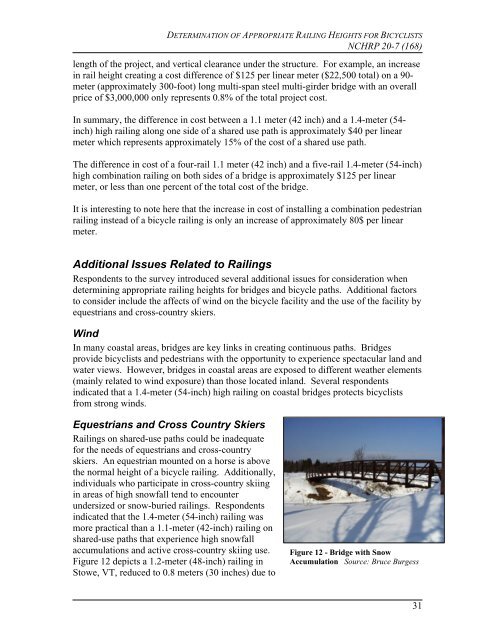Bicycle Railing Height Report - AASHTO - Subcommittee on Design
Bicycle Railing Height Report - AASHTO - Subcommittee on Design
Bicycle Railing Height Report - AASHTO - Subcommittee on Design
You also want an ePaper? Increase the reach of your titles
YUMPU automatically turns print PDFs into web optimized ePapers that Google loves.
DETERMINATION OF APPROPRIATE RAILING HEIGHTS FOR BICYCLISTS<br />
NCHRP 20-7 (168)<br />
length of the project, and vertical clearance under the structure. For example, an increase<br />
in rail height creating a cost difference of $125 per linear meter ($22,500 total) <strong>on</strong> a 90-<br />
meter (approximately 300-foot) l<strong>on</strong>g multi-span steel multi-girder bridge with an overall<br />
price of $3,000,000 <strong>on</strong>ly represents 0.8% of the total project cost.<br />
In summary, the difference in cost between a 1.1 meter (42 inch) and a 1.4-meter (54-<br />
inch) high railing al<strong>on</strong>g <strong>on</strong>e side of a shared use path is approximately $40 per linear<br />
meter which represents approximately 15% of the cost of a shared use path.<br />
The difference in cost of a four-rail 1.1 meter (42 inch) and a five-rail 1.4-meter (54-inch)<br />
high combinati<strong>on</strong> railing <strong>on</strong> both sides of a bridge is approximately $125 per linear<br />
meter, or less than <strong>on</strong>e percent of the total cost of the bridge.<br />
It is interesting to note here that the increase in cost of installing a combinati<strong>on</strong> pedestrian<br />
railing instead of a bicycle railing is <strong>on</strong>ly an increase of approximately 80$ per linear<br />
meter.<br />
Additi<strong>on</strong>al Issues Related to <str<strong>on</strong>g>Railing</str<strong>on</strong>g>s<br />
Resp<strong>on</strong>dents to the survey introduced several additi<strong>on</strong>al issues for c<strong>on</strong>siderati<strong>on</strong> when<br />
determining appropriate railing heights for bridges and bicycle paths. Additi<strong>on</strong>al factors<br />
to c<strong>on</strong>sider include the affects of wind <strong>on</strong> the bicycle facility and the use of the facility by<br />
equestrians and cross-country skiers.<br />
Wind<br />
In many coastal areas, bridges are key links in creating c<strong>on</strong>tinuous paths. Bridges<br />
provide bicyclists and pedestrians with the opportunity to experience spectacular land and<br />
water views. However, bridges in coastal areas are exposed to different weather elements<br />
(mainly related to wind exposure) than those located inland. Several resp<strong>on</strong>dents<br />
indicated that a 1.4-meter (54-inch) high railing <strong>on</strong> coastal bridges protects bicyclists<br />
from str<strong>on</strong>g winds.<br />
Equestrians and Cross Country Skiers<br />
<str<strong>on</strong>g>Railing</str<strong>on</strong>g>s <strong>on</strong> shared-use paths could be inadequate<br />
for the needs of equestrians and cross-country<br />
skiers. An equestrian mounted <strong>on</strong> a horse is above<br />
the normal height of a bicycle railing. Additi<strong>on</strong>ally,<br />
individuals who participate in cross-country skiing<br />
in areas of high snowfall tend to encounter<br />
undersized or snow-buried railings. Resp<strong>on</strong>dents<br />
indicated that the 1.4-meter (54-inch) railing was<br />
more practical than a 1.1-meter (42-inch) railing <strong>on</strong><br />
shared-use paths that experience high snowfall<br />
accumulati<strong>on</strong>s and active cross-country skiing use.<br />
Figure 12 depicts a 1.2-meter (48-inch) railing in<br />
Stowe, VT, reduced to 0.8 meters (30 inches) due to<br />
Figure 12 - Bridge with Snow<br />
Accumulati<strong>on</strong> Source: Bruce Burgess<br />
31


